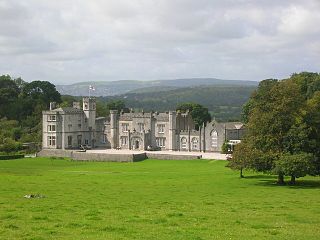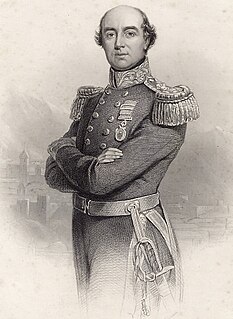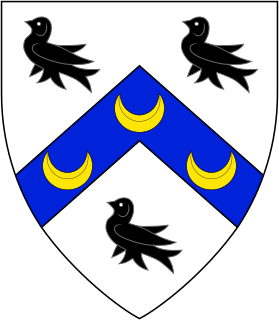
Richard Everard Webster, 1st Viscount Alverstone, was a British barrister, politician and judge who served in many high political and judicial offices.
Sir Charles Hilton Seely, 2nd Baronet, VD, KGStJ was a British industrialist, landowner and Liberal Unionist politician who served as Member of Parliament (MP) for Lincoln from 1895 to 1906 and for Mansfield from 1916 to 1918. He was a Justice of the Peace for Hampshire and Nottinghamshire and the Deputy Lieutenant for Nottinghamshire. He was also a Knight of Grace of the Order of St John.
There have been 19 baronetcies created for persons with the surname Campbell, seven in the Baronetage of Nova Scotia and twelve in the Baronetage of the United Kingdom.
The Stanley, later Stanley-Massey-Stanley, later Errington Baronetcy, of Hooton in the County of Chester, was created in the Baronetage of England on 17 June 1661 for William Stanley, the great-grandson of Sir William Stanley, of Hooton and Stourton, a member of the Stanley family headed by the Earl of Derby. The sixth Baronet assumed the surname Stanley-Massey-Stanley. The ninth Baronet married Mary Haggerston, great-niece and heiress of Henry Errington of Sandhoe House, Northumberland. Their eldest son, the tenth Baronet, represented Pontefract in Parliament. Their second son, Rowland Stanley, the eleventh Baronet, inherited the Errington estate in Northumberland and changed his name and arms to Errington. The title became extinct on the death of the twelfth Baronet in 1893.
The Seely Baronetcy, of Sherwood Lodge in Arnold in the County of Nottingham and Brook House in Brooke on the Isle of Wight, is a title in the Baronetage of the United Kingdom. It was created on 19 February 1896 for the industrialist Charles Seely (1833–1915), son and namesake of Charles Seely (1803–1887). The first baronet's grandson, the third Baronet, was created Baron Sherwood, of Calverton in the County of Nottingham, in the Peerage of the United Kingdom in 1941. The peerage became extinct on his death, but he was succeeded in the baronetcy by his younger brother, the fourth Baronet. As of 2019, the title is held by the latter's grandson, the sixth baronet.

There have been six baronetcies created for persons with the surname Middleton, four in the Baronetage of England, one in the Baronetage of Great Britain and one in the Baronetage of the United Kingdom. One creation is extant as of 2008.
There have been three baronetcies created for members of the Shelley family, one in the Baronetage of England and two in the Baronetage of the United Kingdom. The three recipients of the titles represented two different branches of the family with a common ancestor in John Shelley of Michelgrove. The most famous member of the family is the poet Percy Bysshe Shelley, although he never held any title. The holders of the third and last creation were later elevated to the peerage as Baron De L'Isle and Dudley and Viscount De L'Isle.

There have been eleven baronetcies created for persons with the surname Robinson, four in the Baronetage of England, one in the Baronetage of Great Britain and six in the Baronetage of the United Kingdom. As of 2008 two of the creations are extant while one is dormant.

There have been twenty baronetcies created for persons with the surname Williams, eight in the Baronetage of England, three in the Baronetage of Great Britain and nine in the Baronetage of the United Kingdom. Only five of the creations are extant as of 2017..
Four baronetcies have been created in the surname of Fowler, all of which are now extinct.
There have been two baronetcies created for members of the Baring family, one in the Baronetage of Great Britain and one in the Baronetage of the United Kingdom.
There have been three baronetcies created for persons with the surname Nicholson, all in the Baronetage of the United Kingdom. See also Nicolson baronets.

There have been seven baronetcies created for persons with the surname Watson, one in the Baronetage of England, one in the Baronetage of Great Britain and five in the Baronetage of the United Kingdom. One creation is extant as of 2016.
There have been two baronetcies created for persons with the surname Simeon, one in the Baronetage of England and one in the Baronetage of the United Kingdom. As of 2014 one creation is extant.

There have been four baronetcies created for people with the surname Drake, three in the Baronetage of England and one in the Baronetage of Great Britain.
There have been four baronetcies created for persons with the surname Musgrave, one in the Baronetage of England, one in the Baronetage of Nova Scotia, one in the Baronetage of Ireland and one in the Baronetage of the United Kingdom. As of 2014 two of the creations are extant.
There have been four baronetcies created for persons with the surname Hay, all in the Baronetage of Nova Scotia. Two creations are extinct, one dormant and one extant. A fifth baronetcy in the Jacobite Peerage, although theoretically extant, is not recognised by the Lyon Office.
The Copley baronetcy was first created for Godfrey Copley on 17 June 1661. He was High Sheriff of Yorkshire for 1676–77.

The Dolben Baronetcy, of Finedon in the County of Northamptonshire, was a title in the Baronetage of England. It was created on 1 April 1704 for Gilbert Dolben, son of John Dolben, Archbishop of York. Gilbert was judge of the Court of Common Pleas (Ireland) and MP for Ripon, Peterborough and Yarmouth, Isle of Wight. The 3rd Baronet was an MP for Oxford University and Northamptonshire, and was an avid campaigner for abolition of the slave trade. The title became extinct on the death of Sir John English Dolben, the 4th Baronet, in 1837. William Harcourt Isham Mackworth (1806—1872), a younger son of Sir Digby Mackworth, the 3rd Baronet, took the additional surname Dolben after he married Frances, the heiress of the 4th Baronet.
Sir Richard Worsley, 1st Baronet was an English landowner and politician who sat in the House of Commons between 1614 and 1621.








